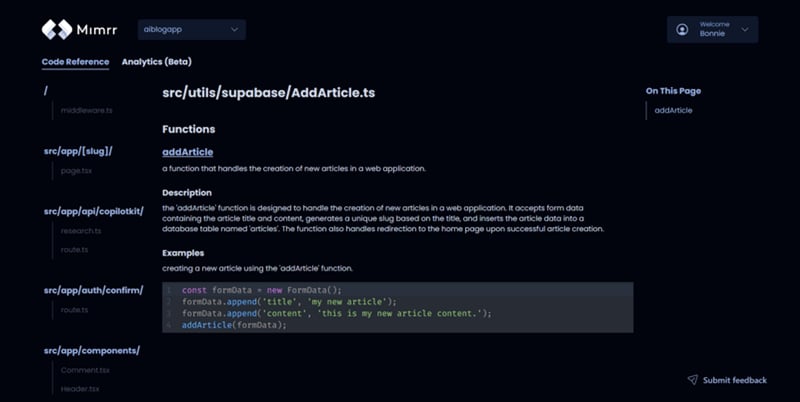Code documentation is an important part of software development that often gets overlooked. Writing good code documentation enhances code readability and maintainability.
Also, good documentation facilitates collaboration among developers by ensuring that others (and future you) can understand and work with your code effectively.
In this guide, you will learn:
Effective documentation uses clear and simple language. Avoids jargon and complex sentences. Consistency in terminology and formatting also enhances readability.
Organize documentation logically, with a clear flow and categorization. Use headings and subheadings to break up the text and make it easier to navigate.
Documentation should always reflect the current state of the code. Regularly review and update the documentation to match code changes. Synchronize documentation updates with version control commits to ensure consistency.
There are several types of documentation, which include,
Inline comments are placed within the code to explain specific lines or blocks of code. They are useful for clarifying complex code logic.
Here are some guidelines for writing good inline comments:
Documenting functions and methods helps others understand their purpose, usage, and behaviour. Good function and method documentation should include:
Modules and packages should include documentation that provides an overview of their functionality and structure.
Key elements include:
Project-level documentation gives a broad view of the entire project and includes readme files and contributing guides.
Good ****README files should:
Good CONTRIBUTINGguides should:
Several tools and technologies can help streamline the documentation process. One such tool is Mimrr.
Mimrr is an AI tool that you can use to generate documentation for your code and analyze your code for:
Leveraging the power of Mimrr code documentation and analytics will enable you to create, and maintain up-to-date code documentation even when there are regular code changes.
In this section, you will learn how to create a Mimrr account.
Step 1:Go to Mimrr and click the Get Started button.

Step 2:Then create your Mimrr account using your Google, Microsoft, or GitHub account.

Step 3:Next, create an organization by adding an organization name and its description. Then click the Create Organization button, as shown below.

After that, you will be redirected to your Mimrr dashboard to connect the codebase repo that you want to generate documentation for.

Congratulations! You have successfully created a Mimrr account.
In this section, you will learn how to connect your codebase GitHub repo to Mimrr to generate its documentation and analytics.
Step 1:Go to the dashboard and open the Connect your code to Mimrr drop-down menu. Then click the Connect button.

Step 2:Then you will be redirected to choose a repository provider. In this case, I will select GitHub as my code provider. Gitlab and Azure Dev Ops are being added.

Step 3:Next, go to your Mimrr dashboard and open the projects section to add your codebase repository by clicking the Add Project button. Once your project is added, it should look as shown below.

Step 4:Click on the project to view the generated documentation, as shown below.

Congratulations! You have successfully generated code documentation for your codebase.
Good code documentation is vital for the success of any software project. By understanding your audience, using the right tools, and following best practices, you can create documentation that is clear, concise, and useful. Start or improve your documentation practices today to reap the benefits of well-documented code.
以上是How To Write Good Code Documentation的详细内容。更多信息请关注PHP中文网其他相关文章!




